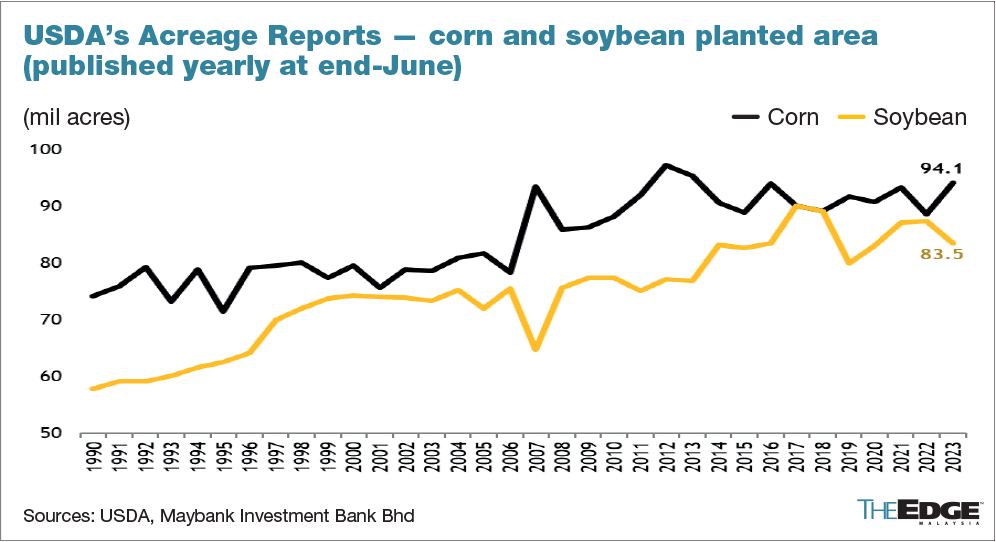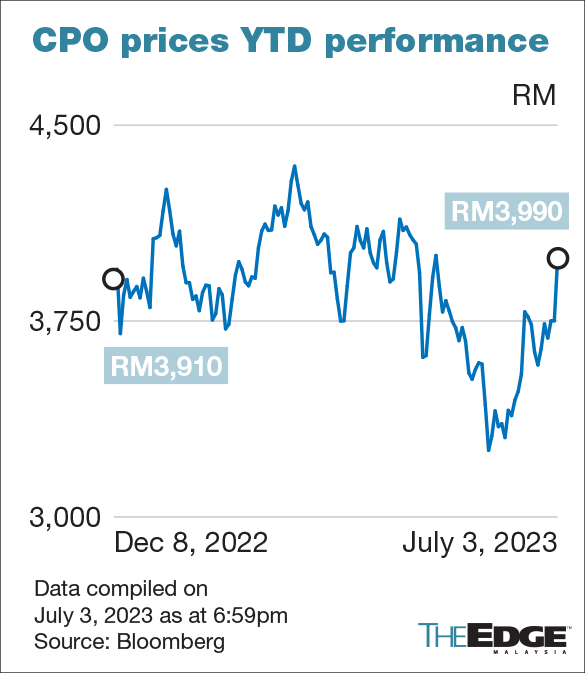
CIMB Investment Bank Bhd analyst Ivy Ng said while the rally on Monday was largely attributed to the USDA report, concerns about the ongoing El Nino weather condition affecting oilseeds and oil palm crops would also play a critical role in keeping CPO prices elevated for the remainder of the year.
KUALA LUMPUR (July 3): Lower soybean production in the US, weather conditions, and a weaker ringgit are expected to keep crude palm oil (CPO) prices above RM3,400 per tonne for the rest of this year, said analysts after prices rose to their highest level since March on Monday (July 3).
CPO prices surged in reaction to the US Department of Agriculture's (USDA) acreage report released last Friday which estimated soybean planted area for 2023 at 83.5 million acres, down 5% from last year. Corn planted acres, meanwhile, increased 6.2% to 94.1 million acres.
This is contrary to traders' expectation of an increase in soybean planted acres and a drop in corn planted area, and resulted in soybean oil prices advancing on Friday, with CPO prices following suit on Monday.
“CPO futures made impressive gains at the start of the week and month notching to a high of RM3,994 (per tonne) or up a solid 205 points or 5.40% on the most active September contract, while the second month August tested a high of RM4,000," noted palm oil analyst Sathia Varqa.
“Nearly 7% gain in soybean oil on the Chicago Board of Trade (CBOT) on Friday following a jump in soybean prices in response to a much lower than expected soybean planted acreage report from USDA spilled over to propel palm futures higher this morning,” the co-founder of Singapore-based Palm Oil Analytics told The Edge.
The last time the CPO prices were at this level was on March 15 at RM3,927 per tonne, according to Bloomberg data. Year-to-date high of RM4,290 per tonne was recorded on March 3.
CIMB Investment Bank Bhd analyst Ivy Ng said that while the rally on Monday was largely attributed to the USDA report, concerns about the ongoing El Nino weather condition affecting oilseeds and oil palm crops would also play a critical role in keeping CPO prices elevated for the remainder of the year.
“If crops continue to be downgraded, then prices may continue to rise,” she said when contacted.
In addition, the USDA report also showed that soybean stock level was 18% lower at 796 million bushels in 2023.
David Ng, senior proprietary trader at derivatives trading firm IcebergX Sdn Bhd, said key soybean planting areas have been experiencing drought, and hence production will be impacted.
Referring to the USDA report, he said a lot of farmers in the US are opting for corn as it fetches higher prices. "Because of that, we see soybean and its byproducts prices are higher."
He warned, however, that problems may brew for Malaysia’s palm oil stockpile if China’s demand for CPO wanes on the back of slower-than-expected economic growth in that country.
“With El Nino in the mix, prices of CPO are going to stay in the higher range for the second half of this year. But there are concerns that slower-than-expected economic growth in China could dampen demand for CPO,” he said.
According to reports, the official manufacturing purchasing managers' index in China inched up to 49.0 from 48.8 in May, indicating slower growth on slower demand at home.
IcebergX's Ng also noted that the spread between soybean oil and CPO is at a premium of US$350 (RM1,633)-US$400 per tonne, which indicated stronger upside for CPO.
“The normal historical range for this spread varies from US$150 to US$250. This spread is considered quite high which means CPO trading is very competitive to soybean oil. The spread does indicate there is a little bit more upside to CPO compared to soybean oil,” he added.
Describing the CPO price rally as a positive knee-jerk reaction, Maybank Investment Bank Bhd said weather developments in July and August are key to near-term fresh price discovery. July and August are crucial pod setting periods which will determine the final soybean yields before harvesting starts in September to October.
“While the expectation is for an improvement in rainfall now, any further weather scare is only expected to be price friendly towards soybean and soybean oil (and in turn, CPO), more so since there is now smaller-than-expected planted soybean acreage,” said Maybank, while maintaining its forecast for CPO average selling prices of RM3,400 a tonne.
- MISC sinks into red for the first time in more than two years as provisions hurt
- Oriental Kopi kicks off FY2025 with 1Q net profit of RM13m
- Petronas Chemicals posts 4Q profit on forex gain, declares three sen dividend
- Malaysia’s international reserves hit US$117.7b at mid-February
- Sports Toto 2Q net profit more than doubles




